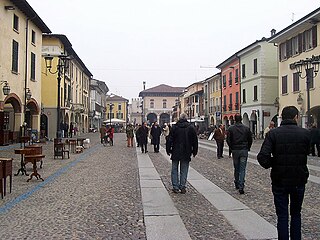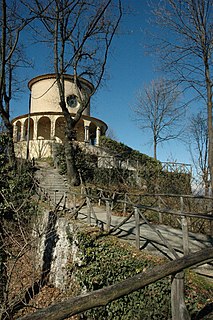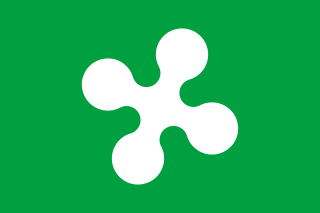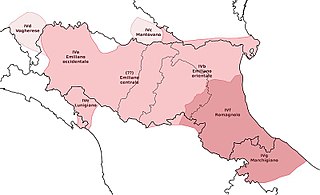
Lombardy is one of the twenty administrative regions of Italy, in the northwest of the country, with an area of 23,844 square kilometres (9,206 sq mi). About 10 million people live in Lombardy, forming more than one-sixth of Italy's population, and more than a fifth of Italy's GDP is produced in the region, making it the most populous, richest and most productive region in the country. It is also one of the top regions in Europe for the same criteria. Milan's metropolitan area is the largest in Italy and the third most populated functional urban area in the EU. Lombardy is also the Italian region with most UNESCO World Heritage Sites—Italy having the highest number of World Heritage Sites in the world. The region is also famous for its historical figures such as Virgil, Pliny the Elder, Ambrose, Caravaggio, Claudio Monteverdi, Antonio Stradivari, Cesare Beccaria, Alessandro Volta, Alessandro Manzoni, and popes John XXIII and Paul VI.

The comune is a basic constituent entity of Italy, roughly equivalent to a township or municipality.

The Province of Cremona is a province in the Lombardy region of Italy. Its capital city is Cremona.

Orzinuovi is a town and comune in the province of Brescia, in Lombardy, Italy.

Roncadelle is a comune in the province of Brescia, in Lombardy.

The province of Varese is a province in the Lombardy region of Italy. Its capital is the city of Varese, but its largest city is Busto Arsizio. The headquarters of the AgustaWestland, the company merged into Leonardo since 2016, the world's largest producer of helicopters, is based in Samarate, a comune of the province. As of 2015, it has a population of 889,410 inhabitants over an area of 1,198.11 square kilometres (462.59 sq mi). The provincial president is Nicola Gunnar Vincenzi.

The Province of Milan was a province in the Lombardy region, Italy. Its capital was the city of Milan. The provincial territory was highly urbanized, resulting in the third highest population density among the Italian provinces with more than 2,000 inhabitants/km2, just behind the provinces of Naples and the bordering Monza e Brianza, created in 2004 splitting the north-eastern part from the province of Milan itself. On January 1, 2015 it was replaced by the Metropolitan City of Milan.

The Province of Sondrio is in the Lombardy region of northern Italy. Its provincial capital is the town Sondrio. As of 2017, it has a population of 181,403.

Northern Italy is a geographical and cultural region in the northern part of Italy. Non-administrative, it consists of eight administrative Regions in northern Italy: Aosta Valley, Piedmont, Liguria, Lombardy, Emilia-Romagna, Veneto, Friuli-Venezia Giulia and Trentino-Alto Adige/Südtirol. As of 2014, its population was 27,801,460. Rhaeto-Romance and Gallo-Italic languages are spoken in the region, as opposed to the Italo-Dalmatian languages spoken in the rest of Italy. The Venetian language is sometimes considered to be part of the Italo-Dalmatian languages, but some major publications such as Ethnologue and Glottolog define it as Gallo-Italic.

San Pellegrino Terme is a comune in the province of Bergamo, Lombardy, Italy. Located in the Val Brembana, it is the home of the beverage company San Pellegrino, where its carbonated mineral water drinks are produced.
A.S.D. SolbiaSommese Calcio is an Italian association football club located in Somma Lombardo and also representing the town of Solbiate Arno, Lombardy. It currently plays in Eccellenza Lombardy/A.

The Sacri Montiof Piedmont and Lombardy are a series of nine calvaries or groups of chapels and other architectural features created in northern Italy during the late sixteenth century and the seventeenth century. They are dedicated to various aspects of the Christian faith and are considered of great beauty by virtue of the skill with which they have been integrated into the surrounding natural landscape of hills, forests and lakes. They also house important artistic material in the form of wall paintings and statuary. In 2003, they were named as a World Heritage Site.

Bondone is a comune located about 50 kilometres (31 mi) southwest of Trento in Trentino in the northern Italian region Trentino-Alto Adige/Südtirol, on the border with Lombardy. It is As of 31 December 2004, it had a population of 693 and an area of 19.2 square kilometres (7.4 sq mi) divided approximately equally between the capoluogo and the frazioneBaitoni which lies on the shores of Lake Idro.

Casnigo is a comune (municipality) in the Province of Bergamo in the Italian region of Lombardy, located about 70 kilometres (43 mi) northeast of Milan and about 20 kilometres (12 mi) northeast of Bergamo.

Ciserano is a comune (municipality) in the Province of Bergamo in the Italian region of Lombardy, located about 35 kilometres (22 mi) northeast of Milan and about 14 kilometres (9 mi) southwest of Bergamo. As of 31 December 2004, it had a population of 5,270 and an area of 5.2 square kilometres (2.0 sq mi).

Brallo di Pregola is a comune (municipality) in the Province of Pavia in the Italian region Lombardy, located about 80 km south of Milan and about 50 km south of Pavia. As of 31 December 2004, it had a population of 832 and an area of 46.3 km².

The Politics of Lombardy, Italy, takes place in a framework of a semi-presidential representative democracy, whereby the President of the Region is the head of government, and of a pluriform multi-party system. Legislative power is vested in the Regional Council of Lombardy, while executive power is exercised by the Regional Government led by the President, who is directly elected by the people. The current Statute, which regulates the functioning of the regional institutions, has been in force since 2008.

Emilian is a group of closely related dialects of Emilian-Romagnol language spoken in the historical region of Emilia, the western portion of today's Emilia-Romagna region in Northern Italy.

The regional cuisine of Lombardy is heavily based upon ingredients like rice, beef, pork, butter, and lard. Despite being a form of Italian cuisine, Lombard food, even more than other cuisine of Northern Italy, tends to have little in common with Central or Southern Italian styles, in many cases lacking the presence of tomato and olive oil, being more meat-based and buttery. In many aspects, Lombard cuisine has much in common with that of Austria and central Europe in general with dishes such as Milanese scallop, Spätzle and Spezzatino also known as Gulasch.



















